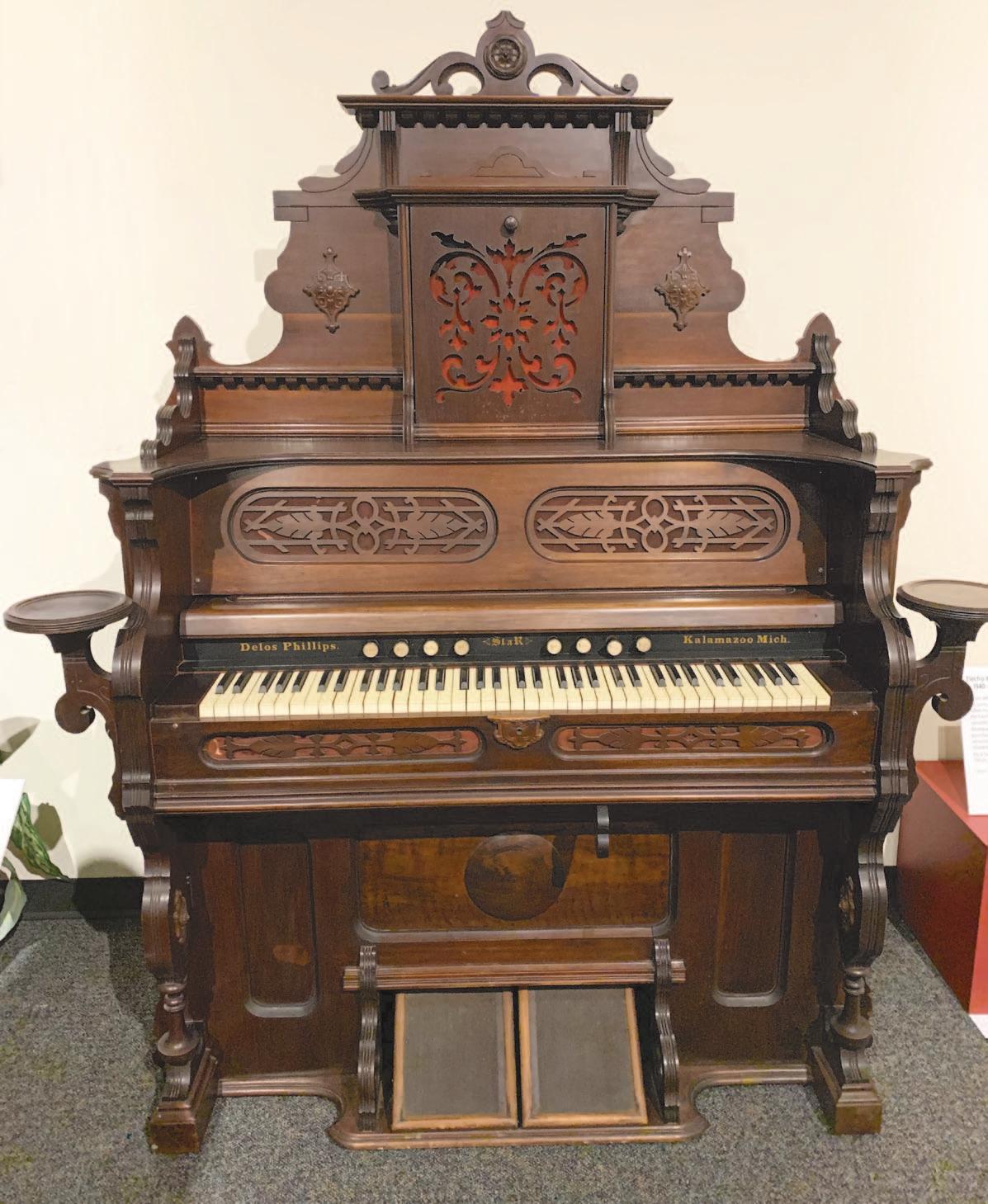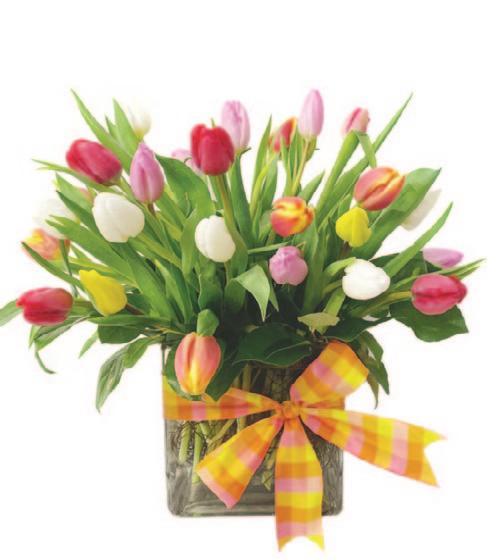






You may be familiar with products such as, taxi cabs, fishing rods, guitars, medicine and hospital beds putting Kalamazoo on the map, but were you aware that pump organs (or melodeons) were built here as well?
Almost 20% of the pump organs in the United States were produced in Kalamazoo back in 1875.
Pump organs were a very popular instrument in the late 1880’s and were used in churches and homes around the world. Pump organs used suction bellows to push air past internal reeds to produce sound.
The manufacturer of organ and melodeon instruments began in Detroit when W.P. Blakeman and A.A. Simmons bought the Detroit Melodeon Company factory in 1854.
Simmons continued to operate the Detroit plant, but Blakeman opened a branch in Kalamazoo in 1855 on N. Rose St., between Water & Main streets. This was a welcome spot for the local music industry and was centrally located to ship deliveries throughout the country.
While the melodeon industry was flourishing, Blakeman was able to purchase Simmon’s interest and became the sole proprietor of the local industry. He operated a general music business, selling small instruments as well as a large assortment of sheet music, pianos, etc., but his leading business was the manufacture of melodeons until 1869.
In 1869, DeLos Phillips, an exCivil war soldier, who rose from private to colonel during the conflict, purchased half of the business from Blakeman, who was getting on in years. Shortly after, Blakeman retired and Phillips became the sole owner. He renamed the business the Star Organ Company and it was moved to 144 Main Street.

More than 2,000 Star organs were designed by J.C. Peskins, the company’s general designer, and sold throughout the nation by 1872. Many of which went into homes in the Kalamazoo vicinity.
The Star Organ Company in Kalamazoo produced 5-6 elaborate pipe organ styles, along with 26 regular organ styles. Few people understood the complicated construction of the reed organ. The instruments required 6 different tradesmen to build them, in addition to the designer.
The Kalamazoo-made Star organ won national attention when it won first prize at the Michigan State Fair battle of the organs, which were built by the country’s best craftsmen. In fact, it was claimed that in every competition since their start in 1855, they had never failed to win first place. The Michigan State Fair put the organ quality and the Kalamazoo music store on the map.
Phillips remained a prominent music dealer in Kalamazoo until his death in 1887. The organ industry, like the melodeon, eventually died in Kalamazoo.
On a side note: I recently saw the organ pictured in this story (circa 1870), at the Kalamazoo Valley Museum in downtown Kalamazoo when I attended their exhibit: Off the Shelves, a furniture & artifacts collection that spans 200 years. This organ is the third Star organ donated to the museum collection. It is quite special to the museum because it was owned by the same family for the past 140 years and was just donated in 2023.
The organ was donated by Dr. Verna Porter Buxton ad Dr. Lawrence Vredevoe, both of California. According to family stories Buston and Vredevoe’s ancestors, Henry and Kate Riemersma of Kalamazoo



purchased the organ in 1870 for $200 (around $3,500 in today’s dollar). When Henry died in 1895, Kate sold it to her husband’s great-niece, Anna Devries. According to a plaque next to the organ at the KVCC Museum, Devries used it in her home in Drenthe, Michigan. She and most of her 8 children learned to play the organ and would play hymns in the parlor after church on Sundays. The family and the piano moved to California in 1976, where it stayed until it was
donated to the museum in 2023.
The organ is no longer playable, but it is a fine example of the fine craftsmanship of this early Kalamazoo-made product.
Sources: KG 12/1/1854, KG 4/12/1872, KG 6/16/1939, KG 12/31/50, Kalamazoo Public Library History room/website, Kalamazoo Valley Museum
Jackie Merriam



Some seeds require a few extra steps to get them to germinate. Seed companies like Botanical Interests give detailed, easy-to-follow sowing recommendations on the back and inside of each seed packet. Below are some general tips to ensure you achieve the best germination from your seeds.
1. Consistent moisture
If you are starting seed indoors, pre-moistening your seed-starting medium helps it absorb water after sowing, making it easier to work with. Seed-starting medium is finer and fluffier than potting soil, holding an ideal amount of water and air for new seedling roots. After sowing seeds, cover containers with clear plastic or a clear dome until seedlings emerge. Take care to keep your soil moist, as germinating seeds are very sensitive to drying out, but avoid making the soil soggy by emptying any standing water from catch trays. While germinating, and when seedlings are small, water gently to avoid shifting seeds around; a mister works well for this. When sowing outdoors, check the soil moisture frequently by dipping your finger in the soil, just past the seed depth. This is the area you want to keep consistently moist during germination, and then deeper after germination. Using a watering wand or watering can with a perforated water breaker will create a gentler stream so seed will be less likely to shift.
2. Sowing Depth
The recommended seed depth is listed on the back of the packet. Some seeds need to be covered by a generous amount of soil in order to germinate because they are large, and/or because darkness aids germination. Others shouldn’t be covered at all or just lightly pressed into the soil because they are very small, and/

or light aids germination.
3. Prevent pathogens
Have you ever experienced dampingoff fungus? This common fungus can cause seeds to rot in the soil or it attacks seedling at the soil line, causing them to fall over and die. The disease can spread rapidly and wipe out an entire container in a short time. The first step in prevention is to use clean, sanitized pots and trays, with drainage. Do not use soil from your yard to start seeds indoors; it can contain pests and diseases. The best option is sterile, seed-starting medium. Air circulation is also an important tool in preventing fungus. Place a small fan on low setting near your seed pots pointed near the containers but not blowing directly on the soil as it could dry out quickly. Finally, indoors or out, if you have sown a lot of seeds in a small amount of space, thin out the seedlings when recommended (see packet), as closely packed seedlings provide the perfect environment for fungal growth.
4. Light Requirements
Indoors, be sure to keep your grow lights on for at least 14 hours a day. This is important, as artificial light is not as strong as sunlight, and sufficient light is important for growing strong, sturdy seedlings.
5. Temperature
A soil thermometer is a helpful tool for getting great germination. Seeds require a specific temperature range for germination to occur and that temperature varies among species. For example, peppers and tomatoes, although easy to germinate in most indoor settings, will germinate better and more quickly with a heat mat underneath until they sprout. Conversely, sweet peas will germinate better in a cooler soil that is only 55°–65°F. When taking outdoor soil temperatures, check the soil in the
Taylor Swift, Miley Cyrus, along with performances by Tracy Chapman and Joni Mitchell, dominated this year’s Grammy’s.
Which leads me to the topic of my column. March is Women’s History Month, a month-long celebration that acknowledges the contributions of women in history and in contemporary society.
The beginnings of Women’s History Month are traced to the first International Women’s Day established in 1911, spurred on by the Women’s Rights Movement.
Women’s Day was largely forgotten until 1969 when a march was organized in Berkeley, California by a woman named Laura X, who took the name to symbolize her rejection of men’s legal ownership of women and the anonymity of women’s history.

morning and evening to find an average as it tends to be less consistent than indoor soil. Check your seed packets’ sowing instructions for specific soil temperature requirements.
Some seeds have hard seed coats and require “scarification” for germination to occur (e.g., sweet peas and morning glories). In nature, the hard seed coat helps to keep them viable longer. The fluctuating weather conditions of winter and early spring help to break down this coat naturally. There are a few easy ways to mimic Mother Nature and “scarify” them yourself. You can soak them in water for 12 to 24 hours, nick them with a file, or clip the seed coat with a nail clipper to allow water to get inside the seed. See packet special instructions for varieties requiring this extra step.
Some perennial seeds specifically require cold, moist winter conditions to germinate. You can “trick” them into believing that they have gone through a winter by sowing them in pots with moist soil and placing them in the refrigerator for a few weeks. Or you can also sow them directly in the ground in the fall in the place you want them to grow, so they can go through natural winter condi-
The march took place on International Women’s Day and led to the creation of the Women’s History Research Center, a central archive of the women’s movement from 1968 to 1974. Laura X also thought it was unfair for half of the population to have only one day a year to be acknowledged, which eventually lead to the month-long celebration in 1987 and spread internationally from then on.
The theme for Women’s History Month in 2024 is Women Who Advocate for Equality, Diversity and Inclusion. The theme recognizes women who speak up and are leading change in their fields.
Celebrate all the amazing women in your life this month!
Jackie Merriam
tions outside. Follow recommended planting depth and then tap them in firmly. An occasional watering in that area throughout the winter may be beneficial in dry climates. You may also try sowing them in containers outdoors. Even in cold climates, this can be quite effective. Use large pots filled with moistened potting soil. Sow your seeds as noted on the packet, then cover with clear plastic and put them in a protected location. About once a month, or more frequently during warmer periods of winter, give them a sprinkle of water. Come spring, you will have a head start on your garden containers! Different seeds have different needs. With a little extra effort, it is easy to ensure you are achieving a fast and high-rate germination.
Wedel’s carries a vast selection of seed packets in-store from many reputable vendors like Botanical Interests, Burpee, Livingston, Renee’s and more. We encourage you to stop in and shop seed packets in-store, or shop at Wedels.com through our partners at Botanical Interests.
From Botanical Interests
Terrie Schwartz Wedel’s Nursery, Florist & Garden Center

Paint chip art continues to be a popular pastime for artists and crafters alike. The allure of those magnificent rows of colors that immediately capture your attention when you walk into a paint store. The kind of display your eye is instantly drawn to that ignites the senses with an overabundance of color choices. Names like Peach Kiss, Fiery Sky, Coral Gable, Poppy Petal and Scarlet Sun make me wonder who the lucky creative is that gets to title all of the paint colors as their job…now how cool is that! And who was it that thought paint chips would be a welcome addition
to art projects? I’m sure glad they did because the ideas are endless. For this tutorial I already knew what I had planned to make, but a quick search online will show you so many other arts and crafts projects to be inspired by. The end result of mine turned out exactly how I envisioned and I’m really excited to keep making more of these unpretentiously artful beauties in an array of colors.
Supplies needed: paint chip samples . circle punch . paper . frame . double stick tape . ruler . pencil


First things first…have so much fun choosing your colors! I was captivated by the vibrant and warm tone palette. Mostly because I am oh-so ready for those summery days. Punch as many circles as you will need for this project. My large frame is 14 x 14 and I used a 1.5” round punch for 25 circles. The small frame is 9 x 9 and a 1” round punch was used for 36 circles. Arrange all of them on a piece of background paper. For accuracy, measure the area and make little marks with a pencil where your circles will be to ensure even spacing. Of course, if you’re more like me and don’t have the mathematical skills to even tell you how to do that (lol) or the patience, just eyeball everything and know it doesn’t have to be perfect. My color layout was deliberately random. You could also create a pattern or an ombre effect and it would be equally as stunning. Once you decide on the placement,
use double stick tape to adhere. Put in a glass frame and hang on the wall, place on a ledge or set on a table. Something so simple yet surprisingly eye-catching!
I want to share a reminder that it is not about the amount of time you spend on creating a project that makes it more valuable or seen as more artistic. To me, it’s about exploring new ideas and techniques that motivate and encourage you to go beyond what you already know. I want you to feel inspired every day and to have the confidence to know that you can do it, whether it’s big or small, takes an hour or several…art is for everyone and anyone can be an artist. xo -Bridget
Email:
bridgetfoxkzoo@gmail.com
Social:
https://www.instagram.com/ bridgetfoxkzoo

A favorite sign of spring, that breaks the drabness of winter, is the sight of colorful tulips in glorious bloom. Tulips are typically grown from bulbs but can also be cultivated from seed. However, when grown from seed, it takes seven to twelve years to produce a flower.
Tulips first appeared in Europe in the 16th century by way of the Ottoman Empire’s spice trade routes. Tulips quickly became popular because of their exotic beauty which bore no resemblance to any other native flower. Thus, tulips became a symbol of wealth and societal status.
These newly discovered tulips were difficult to grow and required careful cultivation. Skilled Dutch agriculturists perfected methods to propagate and hybridize tulips. Holland became the horticultural tulip capital of the world—to this day.
These “rare” and flamboyant plants quickly gained notoriety among affluent and middle-class Dutch. As fundamental economics prescribes, when demand increases so too does price. The more expensive tulip bulbs became, the greater their perceived value and investments escalated. Thus, a feedback loop triggered one of the most historic episodes of speculative mania and irrational exuberance.
In an attempt to hedge against price fluctuations, tulip traders began using contracts to secure future deliveries at predetermined prices. These contracts, known as “windhandel” or “wind trade,” allowed investors to buy tulip bulbs without actually materi-

ally possessing them. This practice fueled greater speculation as individuals then traded based on the promise of tulip bulbs rather than the bulbs themselves.
The tulip craze gripped the Dutch economy between 1636 and 1637 and reached unprecedented heights before crashing spectacularly on February 3, 1637–triggered by a failure that day to sell even a single bulb at a tulip auction in the city of Haarlem. Panic ensued, and a massive selloff followed as investors rushed to liquidate their tulip holdings. Prices plummeted, leaving many investors with worthless contracts and total financial losses. The event became famously known as the Tulip Bubble.
At the peak of the Tulip Bubble in early 1637, prices reached astronomical levels. Some of the rarest tulip


bulbs fetched prices that far exceeded the annual income of even skilled workers. A speculative fever had spread across all segments of society as people invested heavily in the tulip market hoping to make a fortune.
The British journalist, Charles Mackay, in his book Extraordinary Popular Delusions and the Madness of Crowds, published in 1841, provided an example of the exaggerated value of one rare tulip that traded for: “four fat oxen, eight fat swine, twelve fat sheep, two hogsheads of wine, four turns of beer, one thousand pounds of cheese, two tons of butter, a bed, a silver cup, a set of fine clothes, two lasts of wheat, and four lasts of rhye.”
The Tulip Bubble caused overwhelming financial and social consequences including widespread monetary losses, economic instability, financial ruin and bankruptcies, a credit collapse, loss of confidence in speculative ventures, and pervasive social discontent.
The Tulip Bubble left a lasting impact on Dutch society. Trust in speculative ventures vanished and tulip mania became a cautionary tale about the dangers of irrational exuberance. The Dutch government, recognizing the need for regulation, intervened to stabilize the economy and prevent future bubbles but the damage was done.
The Tulip Bubble of 1637 remains a fascinating chapter in economic history, showcasing the extreme
consequences of speculative fervor and the fragility of financial markets. It serves as a reminder that even the most alluring and seemingly valuable assets can become the victims of irrational exuberance, with repercussions that extend far beyond the realm of finance.
Despite such cautionary tales, we are not immune to irrational exuberance. The most recent example was the tech boom NASDAQ “Dot-com Bubble” of early-2000s. Fortunes were won and lost in the battle to buy and sell rising-star dot-com companies. Such investments caused the NASDAQ composite index to rise more than 800% before it collapsed.
And who can forget the adorable stuffed animal toys–”Beanie Babies”, by Ty Inc., that became all the rage in the 1990s. They were originally priced around five dollars. When the company announced that it was “retiring” some of the popular Beanie Babies, Beanie Babies became highly collectable and highly traded. In 1997, eBay sold a half-billion dollars in Beanie Babies—accounting for 6% of eBay’s total sales that year!
Yes, Charles Mackay in 1841 couldn’t have described this human tendency any better than when he included the phrase in the title of his book, “…the madness of crowds.”
James D. Coppinger





T The T he Tainted Cup ainted Robert Jackson Bennett (Del Rey)
In a world where leviathan blood allows people to acquire amazing abilities, a brilliant investigator, Ana, and her sidekick in training, an “engraver” named Din capable of recalling details with amazing accuracy, work together to uncover the culprit behind the grisly death of a wealthy official. This hugely enjoyable fantasy and mystery blend will leave readers eager for another installment
—Mara Bandy Fass, Champaign Public Library, IL
NoveList read-alike: The Witness for the Dead by Katherine Addison

T The Book of L he Loovve e Kelly Link (Random House)
Three teens are newly back from the dead. Endowed with mysterious magical powers, they have to figure out how they died and what to do to keep from returning to the world of the dead. A huge cast of characters from the underworld and from their cute New England seaside town help (and hinder) them. This romantic, sexy, funny, and queer novel is recommended for readers who enjoy mythology and magical hijinks
—Emily Heath, Brooklyn Public Library, NY
NoveList read-alike: Magic for Liars by Sarah Gailey
A After Annie: A No fter Annie: A Novveel l Anna Quindlen (Random House)
The aftermath of grief following the unexpected death of Annie is told through the eyes of husband Bill, 13-year-old daughter, Ali, and best


Book One in the Saga of the Unf One of the Unfated ated Danielle L. Jensen (Del Rey)
We're all used to the Viking stories that center around men. This story features Freya, who has to marry a fanatical chieftain to protect her family and her land. She's been blessed with magical powers, and it's been foretold that she'll be the one to unite the kingdoms. This is a great start to a new series that will appeal to everyone who enjoys nonstop action with a strong female warrior and a steamy love story to boot
—Kimberly McGee, Lake Travis Community Library, TX
NoveList read-alike: The Serpent & the Wings of Night by Clarissa Broadbent

T The Book of Doors he Book Gareth Brown (William Morrow)
Cassie likes her quiet life working in a bookstore in Manhattan. When one of her favorite customers dies in the shop one night, she finds a book in his possession with an inscription to her and the new found ability that allows her to go through any door and come out wherever she wishes This fantastical time travel novel has several interesting twists, including the final one
—Jennifer Winberry, Hunterdon County Library, NJ

T The F he Foox Wif x Wife e Yangsze Choo (Henry Holt & Co )
This wonderful weaving of fantasy and folklore builds on ancient lore that foxes can change form into humans
When a young woman is found dead in the snow, Bao, a thoughtful investigator, is hired to explain her death. Rumor has it that foxes might be involved, and Bao follows clues shrouded in mystery to find the story of her death—and more Highly recommended for fans of fantasy and whodunits that feature vivid characters and settings
NoveList read-alike: Ink Blood Sister Scribe by Emma Torz —Mitzi Sherwood, Honey Grove Library, TX NoveList read-alike: Unraveling by Karen Lord

T The T he Teacher eacher Freida McFadden (Poisoned Pen Press)
Eve, a married high school math teacher, has been warned that Addie, a teenage student coping with trauma and alienation from her fellow classmates, could not be trusted. Inappropriate conduct soon occurs. The twists and turns in this psychological thriller will leave the reader with a deep feeling of unease
—Kristin Skinner, Flat River Community Library, MI
NoveList read-alike: Reconstructing Amelia by Kimberley McCreight
When Grump Grumpy Met Sunshine y Sunshine Charlotte Stein (St. Martin's Griffin)
When Mabel meets exfootballer Alfie to discuss ghostwriting his memoirs, it doesn't go well. After he convinces her to work with him, the press gets involved, and they decide to pretend to be a couple. Filled with play ful banter, embarrassing mishaps, and believable, respectful relationship building, this is great rom-com.

W Wandering Stars: A No andering Novveel l Tommy Orange (Knopf)
Orange's second novel is a stunning achievement depicting over a century's worth of atrocities against the indigenous people of America, while also being a multigenerational family story full of the richly drawn, fascinating characters first introduced in There, There
—Rachel Rooney, Mid-Continent Public Library, MO
NoveList read-alike: Calling for a Blanket Dance by Oscar Hokeah
A L A Loovve Song f e for Ricki Wil or Wilde de Tia Williams (Grand Central)
Ricki has been given an opportunity to achieve her dreams. Ezra is looking for an opportunity to be himself They were destined to meet! With flashbacks to the Harlem Renaissance, this entertaining read is both modern and classic and does not disappoint. (Do yourself a favor and play some jazz in the background while reading.)

Every evening, as I prepare for bed, I climb the stairs to my bedroom on the top floor of my little red farmhouse. Every morning, wrapping my robe around me, I make my way down again, already focused on that first cup of steaming coffee. I never rush, though. I take my time, pausing on each step to greet the beloved faces on what I call my Comfort Wall.
These are the faces of my Beloveds. My parents, both of whom have passed by now. My children, daughter and son. My blonde brood of grandchildren, there as newborn innocents but also as they are now, with a twinkle of mischief in their pre-teen eyes. There are the generations of elders, too—my grandparents, long gone but for whom my heart still aches, and the centuries-old home of my great-grands on the shore of the Baltic Sea. Among the human faces are my sweet fur babies, my companion dogs and yes, a photo of my very first flock of six pampered chickens when I first moved to the country.
I call it my Comfort Wall, because seeing these faces every single day soothes my heart and prepares me to either take on the day or prepare for sweet dreams. To the rest of the
interior design world, however, this is known as a “gallery wall.”
How to design a wall that brings you comfort and a moment of joy every time you pass by it? A gallery wall doesn’t have to be family photographs. Hey, not everyone loves their relatives. It can also be a wall of favorite art pieces. You may choose matching frames or, as I did, make every frame a different one. Picking unique and colorful frames from thrift stores and garage sales can add an element of fun as you build the arrangement.
When beginning to put up your chosen images, start by hanging your largest piece as an anchor. It may or may not be the actual center of the arrangement. If you have a second larger piece, place it some distance from the first.
Use a mix of horizontal and vertical images to add interest. You may want to lay out the entire arrangement on the floor or a table first to make sure the arrangement works for you. In my case, I have added individual pieces as time goes by. That can work, too. Step back to access the right spot for good balance.
If using artwork, consider a similar color palette for all of the pieces so

that the blend is cohesive. Subject matter may also be similar—all seascapes, all animals, all butterflies. It’s an idea, not a rule. Think about framing children’s artwork alongside photos of their beautiful faces. You might also intersperse unframed pieces between framed pieces, such as Mama’s favorite wooden spoon alongside a photograph of her baking bread in the kitchen, or a sheet of music next to your talented cellist uncle. Your sister’s necklace that she wore every day as a teenager nailed
up beside a photo of her smile in braces works. Just make sure she doesn’t mind that it is missing from her jewelry box.
A gallery wall can be a wonderful conversation starter with guests, introducing them to who you are and what and who you love. Have fun creating or ask the family to help, each with their own favorite items and images.
Zinta Aistars

When it comes to your heart, you want the best. At Bronson, our teams are dedicated to quality and are skilled at coordinating medical and surgical services to meet each patient’s unique needs. When you choose one of our cardiologists or surgeons, you get the skill, compassion and fierce determination of all of us. That’s why Bronson Methodist Hospital is one of the 50 Top Cardiovascular Hospitals in the nation and the Bronson system is the top choice for heart care in southwest Michigan!
Learn more at bronsonhealth.com/heart

Sledding is a journey that turns snowflakes into treasured memories -Author Unknown
Warmer temperatures are inviting the mud to come out and play after being blanketed with a very thick downy quilt of snow. The days until Spring are much less than the Winter days remaining. And yet, I can’t help thinking of the joy of hiking up and sliding down snow-covered hills.
As a child, I longed that the ample acreage of my backyard not be so flat. Fifty-acres to play, and the only hills I could find were the creek banks. If the water was iced over, I would take my round saucer and attempt to slide down an embankment. I have faint memories of sliding down snowbanks created by a plow. Neither option

offered the thrill like a friend’s hill where she lived.
Oh, that hill held the BEST sledding parties! Sliding single. Double. Piling three at a time on one of those flexible flyer wooden sleighs one of us would bring. I vaguely remember our momentary grumbles of having to hike back up the hill after such a quick slide down. But I definitely remember the excitement of a wellworn sled path taking us faster and farther each time we went down that steep hill.
I giggle to myself now when driving by that hill, gosh, let’s see, fortyfive years later give, or take. Maybe I would feel different standing at the bottom or top of the hill, but from the road it doesn’t look so steep now. In my memory it will always be as










tall as a mountainous ski hill. I’ll hold on to the memory that way!
During the last few years my hiking up hills has migrated to mountains, and when weather conditions are right, the opportunity to glissade. Think of glissading as the adult version of sliding downhill through snow not on a saucer or cool flexible flyer sled but instead in waterresistant or snow pants. Oh, and the down is a tad bigger by, mmm, a few thousand feet in width, length, and altitude.
I certainly didn’t look at the view from the top of a sledding hill like I look at the mountain horizons. Nor did I think about what I was learning about life; about ups and downs and climbs and breathtaking views once reaching the top. It was with heavy
boots and equally weighted snow outfits that most of the time felt like feathers hiking up the sledding hill. It was exhilarating certainty we knew how to fly when sliding back down. It was having fun gaining rosy, red wind-burned cheeks and a reason to sleep well when the day was done. I am in reverent awe now when I stand at the base or summit of a mountain, tiny me beholding the grandness in my view. But in my childhood memory the sledding hill will remain taller than any peak I see. I’m holding on to the memory that way!
Christine Hassing https://christinehassing.com







Today, more than 52 years after the last Ed Sullivan Show aired on March 28, 1971, I can still hear his distinctive voice.
“And now…right here on our stage…
“Now, for all you youngsters in the audience…
“Tonight, we have a REALLY BIG shew…”
For 23 years, Ed Sullivan was a cultural phenomenon. Every Sunday night, families and friends would gather around television sets to be entertained by singers, musicians, actors, acrobats, plate spinners, and puppets on his show. For many entertainers, appearing on Sullivan’s show was a career high point.
Ed Sullivan was the king of variety shows—shows that featured a range of entertainment including skits, musical numbers, dancing, and acrobatics—during an era of dozens of such shows, hosted by Jackie Gleason, Andy Williams, Milton Berle, Dinah Shore, Red Skelton, and at least 150 others. Sullivan’s show became the longest-running variety show in history. Television critic David Hinckley called it “the last great American TV show” and “one of our fondest, dearest pop culture memories.”

Comedian Fred Allen said “Ed Sullivan will last as long as someone else has talent,” and Alan King quipped, “Ed does nothing, but he does it better than anyone else in television.”
Edward Vincent Sullivan was born in 1901 in Harlem. His family moved to nearby Westchester County where Ed exceled in music and sports. In high school, he began writing for local newspapers, establishing an interest in journalism, especially coverage of sports and entertainment. His connections led to an intertwined career as an impresario—an organizer of entertainment events— while he was still in his 20s.
In 1948, CBS hired Sullivan to host a live weekly Sunday-night variety show from Broadway. The show, originally called Toast of the Town, became The Ed Sullivan Show in 1955.
Appearing on Sullivan’s show was a major achievement. It immediately boosted the career of Elvis Presley when he first appeared in 1956, and for Buddy Holly and the Crickets in 1957.
The Beatles’ first appearance on Sullivan’s show on February 9th, 1964, has been called “one of the seminal moments in television history” as 73 million people,



more than one-third of the U.S. population, tuned in to see and hear what the loud music, long hair, and screaming was all about. The band appeared three more times that month and led to “the British Invasion” as Sullivan soon hosted The Dave Clark Five, Rolling Stones, Herman’s Hermits, the Animals, Petula Clark, and more.
Later that same year, Sullivan began showcasing Michigan talent with the first appearance of the Supremes. The Motown girl group appeared on Sullivan’s show 14 times over five years, and Sullivan developed a genuine affection for “the girls,” who were followed by other Motown groups, including the Temptations, Smokey Robinson and the Miracles, Stevie Wonder, the Four Tops, the Jackson 5, and others.
Sullivan’s bookings of Motown groups highlighted his social color-blindness. From the first days of his show, Sullivan invited African American entertainers to perform. When he shook Nat King Cole’s hand and kissed Ella Fitzgerald’s cheek, it was a precedent that offended some Southern CBS affiliates who threatened to boycott Sullivan’s show. Invariably, he held firm: If you had talent, he wanted you on his show.


In addition to acts that appealed to grown-ups, Sullivan made sure the kids were entertained, with visits by the likes of the Muppets, Spanish ventriloquist Señor Wences, and “the little Italian mouse, Topo Gigio.” Sullivan frequently asked celebrities in the audience to stand and be recognized.
Despite still having respectable ratings in 1971, CBS canceled the series along with others in the older demographic, including The Beverly Hillbillies, Red Skelton, Jackie Gleason, and Lawrence Welk Ed Sullivan died three years later at age 73.
Tony Ettwein
A.Sullivan & Marciano: “Sullivan and boxer Rocky Marciano remove their jackets, pretending to prepare to fight, c. 1955.”
B.: Ed Sullivan on stage during his show, thoroughly enjoying his interaction with the audience. Courtesy the Everett Collection.
C.: Some of Ed’s favorite people, Detroit’s Supremes, performed on his show 14 times. (Florence Ballard, Diana Ross, and Mary Wilson)

Tips on how to help you cope when you are struggling.
The winter blues could be a sign of cabin fever or potentially seasonal affective disorder, or SAD. Cabin fever, by definition, is a psychological symptom people may notice when they are confined to their homes for longer than regular periods. SAD refers to a type of significant depression that is re-occurring, and episodes occur during the same season each year. SAD is often referred to as the “winter blues”; however, some people may experience SAD in the summer, but it is less common. SAD is typically related to the amount of sunlight people are exposed to. To be diagnosed with SAD by a mental health professional, you must meet the criteria from the DSM-5-TR for at least 2 years. Symptoms of cabin fever may be:
• Restlessness
• Irritability
• Loneliness
Not every person experiences the same symptoms if they battle with SAD. Some symptoms of SAD may include:
• Hopelessness
• Sadness
• Thoughts of suicide
• Too much sleep
• Change in appetite
• Weight gain
• Lower energy
• Fatigue
• Difficulty concentrating
• Irritability
• Avoidant social situations
• Increased sensitivity in social situations
If you experience SAD in the summer, some of the symptoms may include:
• Poor appetite
• Weight loss
• Insomnia
• Agitation
• Anxiety
Symptoms of summer SAD are:
• · Poor appetite
• · Weight loss
• · Insomnia
Typically, SAD is mild or moderate. However, some individuals may experience severe symptoms, making it difficult to function in their daily lives. Sometimes, SAD is misdiagnosed as mononucleosis. In additionally to the above symptoms, both winter and summer SAD could include the following:
• Guilt
• Loss of interest or pleasure in doing things
• Somatic symptoms such as headaches or stomach aches
What causes SAD? The cause of SAD is unknown. However, there is evidence that lower melatonin levels, which is a hormone regulating sleep, could be linked to SAD. People who experience SAD may also have difficulties regulating the serotonin, which influences mood. Insufficient levels of Vitamin D have also been found to be connected to those who suffer from SAD and depression symptoms. People who experience SAD may have a family history of depression. It tends to be more common in women than men.
Treating SAD is vital for your overall health. Some common treatments are:
• Light Therapy
• Vitamin D
• Self-Care
• Plan a trip somewhere warm
• Physical Activities (join a gym and follow through with a workout plan)
• Positive attitude
• Antidepressant medication
• Counseling
Cabin fever could trigger thoughts related to COVID and not being able to get out as often. Cabin fever can feel isolating and lonely. It is not a diagnosis in the DSM-5-TR but has many emotional and physical side effects that can affect people’s daily lives. Many people are social creatures, and being unable to do so can contribute to feeling more down than usual. Some of the reasons someone may experience cabin fever:
• Inability to connect with others socially.


• Not participating in everyday activities
• Burnout from work
• Worried about finances
• Too much or too little work
Here are some signs of cabin fever:
• Boredom
• Irritability
• Restlessness
• Impatient
• Anxiety
• Little motivation
• Loneliness
• Hopelessness
• Depression.
Some behaviors an individual may have if they are experiencing cabin fever:
• Not completing daily or weekly tasks.
• Sleeping too much or having trouble sleeping.
• Difficulty concentrating.
• Change in hygiene.
• Change in eating habits.
• Drinking too much alcohol Regardless if you are experiencing cabin fever or SAD, it is essential to know how to cope with the emotions you are experiencing. The following are things that you can do to help yourself through this challenging time:
• Spend time in nature.
• Take care of plants or grow herbs.
• Watch for sunrises or sunsets.
• Play with your pet.
• Get an adequate amount of sleep.
• Connect with family or friends.
• Focus on positive thoughts.
• Journal
• Give yourself grace.
• Allow yourself permission to rest.
• Read a book.
• Do something you enjoy.
• Keep moving.
Remember, it can be challenging to navigate these emotions and feelings related to cabin fever or SAD. It is okay to contact a mental health professional to learn strategies to help you navigate difficult times. It is encouraged to seek help if you notice new or worsened feelings of anxiety or depression, worsening obsessivecompulsive biovars, lack of interest in things you enjoy, low motivation, problematic sleeping patterns, change in diet, or an increase in an inability to concentrate. You can find a mental health professional that may be right for you on Psychology Today. Remember, if you do reach out for help and don’t feel your therapist is a good fit, it is okay to shop around to find one you can connect with.



School will be out of session in just a few short months, and children of all ages will be on their way to summer camp. Many great childhood memories stem from summer camp. It is a great way to get children out in a structured environment where they can have safe fun. So many summer camps are available; it may be silly to start thinking about it already, but camps fill up fast.
While summer camp can be so much fun, many children have anxiety revolving around the thought of going to camp. Also, some children may not have experienced an overnight camp and fear going. Remember, having some anxiety is okay. However, if the anxiety is overwhelming, making life difficult, or even debilitating, it may be good to have your child talk with a therapist. Explain to your child they aren’t the only ones who might have anxiety around camp, but avoiding going isn’t healthy. Avoidance can become an unhealthy coping mechanism that may feel good at the moment, but later, it could cause other problems such as:
• Missing out on things
• Creating more intense anxiety related to social events.
• A pattern of avoiding things
• Feeling left out or isolated. You aren›t the first parent worried about sending their child to an overnight camp, and you won›t be the last. You may feel overwhelmed by your child›s concern about going to camp. On the

other hand, you know the benefits outweigh the cons, and your child could have a blast trying new experiences that the camp offers. Here are some things you can do to decrease your child›s worries while helping them overcome the fear of going away to camp.
• Empathize with your child. Let them know you understand what they are saying and that feeling a little worried about going to camp is okay. Normalize their feelings by letting them know other kids share the same worry. Help your child find ways to ease the worry. Don›t shame them by calling them a «baby» or saying, «Everyone goes to camp.»
• Prepare them ahead of time. Going out in nature will reduce screen time and build new friendships.
• Practice having overnight opportunities with friends or family.
• Do a guided imagery of what being at camp overnight may look like.
• Build their confidence and selfesteem through verbal praise. Act excited when they stay nights away from home.
• Don›t let them see your worries; worrying can be contagious, and children can pick up on their parents› worrying.
• Send care packages while they are at camp to let them know you are thinking about them.
• Plan a reward such as ice cream or a family movie/game night when you pick them up from


camp to give them something to look forward t
Staying overnight somewhere with strangers at camp can feel uncomfortable to some people. Allowing your child to express their feelings while encouraging them to step out of their comfort zone could open new doors and opportunities for your child. It also could teach your child to face their fears and set them up for success when trying new things if they take the plunge and jump into summer fun at camp. If your child is still getting ready for an overnight camp, many camps offer daytime experiences.
Some children may feel uncomfortable going to camp alone. Meeting new people or not knowing anyone at the camp could be scary. However, don’t let this keep you from sending your child to camp. They may make great friends and have fun-filled experiences that last a lifetime. Camps recognize that some children may feel nervous about going to camp, and they are trained to help kids feel included. Another strategy could be talking to your child’s friend’s parents/ guardians to see if they could have a buddy or buddy sign up for the same camp. Having the buddy system when signing up for camp could make the experience less scary and exciting.
Allow your child to look at the various camps to sign up for. Let them choose one or a few, depending on your family budget. Make your child a part of the
experience; it may make them feel they have a choice in the camp, making it more enticing. Have your child help pack for camp or shop for essentials needed, making them take ownership of the camp experience. Let your child talk about how they feel going off to camp and what they are excited about or worried about. Open a dialog with your child, which allows them to pull the words they feel inside and get them out. When talking to your child about camp, let them know you hear their concerns and can see their excitement, but encourage them to step out of their comfort zone by not enabling them when they say, “I don’t want to go to camp because it is too scary” and then letting them stay home. Enabling them could set them up for future failures.
Remember, anxiety and worry about going to camp doesn’t mean your child has an anxiety disorder; it is developmentally appropriate to have some fear or worry. Consider attending camp a developmental milestone, setting your child up for college and beyond. Feeling worried about new experiences is normal, and trying new things can be intimidating, but would your child feel the rewarding benefits of getting their feet wet in new waters instead of regretting not going and having the experience?
Dr. Julie Sorenson, DMFT, MA, LPC


Serving as a blessing and for a short time a woeful curse, I could not think of a more appropriate food for St. Patrick’s Day than the potato!
With historical origins from the Incas, who grew potatoes prolifically in what is now Bolivia and Peru, it was there that this nutritious tuber captured the attention of the Spanish in the 16th century, while they were capturing the Incan empire, too!
Those conquistadors need also be credited with literally carrying the potato all the way to Europe, which is how this tuber was able to be rooted in Ireland’s soil.
Once there, Irish farmers found the potato to be the perfect match for their soil, which caused it to grow prolifically and become the staple crop of Ireland.
Loaded with protein, vitamins and complex carbohydrates, potatoes not only improved the diet and health in Ireland, but also doubled their population from 4 to 8 million between 1780 and 1840.
Sadly, when the blight came in 1845 (lasting until 1847), it devastated their population.
Fortunately, by the grace of God, enough potato plants survived the blight to turn the situation around. This enabled the Irish (and the rest
of us) to enjoy all the benefits that potatoes provide up and to this very day!
Recalling childhood memories of peeling potatoes with Mom, I can still hear her issuing her usual warning to me as I peeled, “Be sure to remove all the eyes, and anything green, because it’s no good to eat!” . Many, many decades later something suddenly possessed me to fact-check Mom, and guess what? She was right!
According to numerous online sources, potatoes do possess solanine and other glycoalkaloids, which can be toxic to humans, and can lead to headache, vomiting, and other digestive symptoms.
Solanine is concentrated in the potato’s eyes, sprouts, and skin, but not in the pulp, which is why it is best to peel and core out eyes and sprouts prior to preparing them. Stressful growing conditions and exposure to any light causes these

alkaloid toxins to steeply increase. Potatoes reveal to us when they’ve been exposed to light because it also triggers chlorophyll formation, causing the potato to turn – you guessed it – green!
Greenish skin indicates high alkaloid levels, so be sure to remove any green skin and the surface layers of the potato pulp that came in contact with the green.
If the greening has penetrated into the pulp or a potato taste is noticeably bitter, pitch it because it is not fit to eat.
Potatoes are safe to eat, even if sprouted, so long as they are firm and not wrinkly or shriveled. Simply remove the sprouts, and as Mom said, don’t forget the eyes, which is why the peeler has that funny, sharp tip on its end!
Here now are some special variations of my favorite way to indulge in potatoes on St. Patrick’s Day –ENJOY!
Laura Kurella is an award-winning home cook who has just released a new edition of her children’s book, “A Delicious Day at Mrs. K’s,” which teaches K-2nd graders the importance of nutrition, where to find it, how it got there, and all the amazing things it can do for you! Look for it on Amazon.














(circa 1942)
1/4 cup milk
2 large potatoes, peeled and chunked
1 medium onion, quartered
2 eggs
3 tablespoons flour
1 teaspoon baking powder Unrefined sea salt and black pepper, to taste
1 cup frozen peas, thawed
3 large russet potatoes, peeled
2 tablespoons cornmeal
2 tablespoons flour
1 1/4 teaspoons curry powder, divided use
1 teaspoon unrefined sea salt, divided use
1/2 teaspoon turmeric
1/2 teaspoon black pepper
1 egg, lightly beaten
1/2 cup plain yogurt
2 tablespoons mango chutney
1 teaspoon lemon juice
1/4 cup olive oil
In a large bowl, using a potato masher or the back of a wooden spoon, mash the thawed peas. Grate the potatoes into the bowl with the peas. Add cornmeal, flour, 1 teaspoon of the curry powder, 3/4 teaspoon of the salt, the turmeric, and the pepper. Stir to combine; add egg and mix until well combined. In a
Place all ingredients in a blender, in the order of the recipe and blend, pulsing well until mixed. Pour by tablespoon onto a hot griddle, 365 degrees, that has been sprayed with cooking spray. Flip cakes when edges are brown. Great served with sour cream, applesauce, jam, syrup, or cheese.
Approximate servings per recipe: 4.
medium mixing bowl, stir together the remaining 1/4 teaspoon of curry powder, the remaining 1/4 teaspoon of salt, the yogurt, chutney, and lemon juice. Refrigerate until serving time. In a large, heavy, non-stick skillet, heat 1 tablespoon of oil over medium heat. Using about one heaping tablespoon per pancake. (Skillet should hold about 4 pancakes at a time.) Flatten mixture slightly with a spatula. Cook pancakes 4 minutes, then flip, and cook another 4 minutes or until golden brown, crisp, and cooked through. Remove pancakes from the skillet, then transfer them to a serving platter and keep warm in a 300 degrees oven until serving. Repeat cooking pancakes, adding one tablespoon of oil to the pan each time, until all are cooked. Serve pancakes with chutney-yogurt sauce, if desired.
Approximate servings per recipe: 6.
1
1
1/2
1


Approximate servings per recipe: 4.


Provides glimpse of life of patients and employees over facility’s 165 years
Did you know that Michigan’s longest-operating mental hospital is in Kalamazoo? Learn the fascinating history of the Kalamazoo Regional Psychiatric Hospital at a new exhibit at the Kalamazoo Valley Museum on display from Feb. 3, 2024, through Jan. 19, 2025.
“Kalamazoo State Hospital: 165 Years of Psychiatric Care” examines the history of its patients, employees and buildings on its Oakland Drive campus. The exhibit features a range of items, from life-size versions of

historical photos to patient artwork and original furniture, such as rocking and dining-room chairs.
Expect recreations of patient and employee sleeping quarters; at one time, employees were required to sleep at the hospital. There will also be a copy of a book written by a patient about her experience at the facility, plus mental health resources and several patient case studies that are being used with their families’ permission.
Starting in 1848, the state legislature saw the need for addressing the mental health of its people and began taking steps toward creating the first mental hospital overseen by

the state. One hundred and sixty-five years later, the Kalamazoo Regional Psychiatric Hospital still operates on the original location where the first hospital opened in 1859.
Throughout its history, several innovative programs began, such as a training school for nurses specializing in psychiatric care and an occupational therapy program in partnership with Western Michigan University.
The hospital also utilized several hundred acres of surrounding farmland for diversified farming, such as cattle for milking, fruit orchards and vegetable gardens. This was accomplished by the implementation of the colony farm system, which estab-
lished a “colony” made up of numerous cottages having a capacity not to exceed 30 patients.
The resulting Colony Farm was believed to have a curative effect on patients by keeping their bodies and minds active toward a common goal.
Admission is free to the exhibit and the museum. Visit kalamazoomuseum.org for more information. The Kalamazoo Valley Museum is operated by Kalamazoo Valley Community College and is governed by its Board of Trustees.
Photos Courtesy of Kalamazoo Valley Museum





I often come across little tidbits of information on health and wellness that I find interesting but are too short to expand into 500 or so words. Here are some I hope you find interesting and useful.
• Tai Chi is good for those with Parkinson’s disease. In a study that followed 330 older adults with Parkinson’s disease for about four years, those who practiced Tai Chi for 60 minutes twice a week, experienced a slower progression of the disease and were less likely to have symptoms, such as tremors. They were also less apt to increase their medication doses than those who did not participate in the program.
• People in discomfort rated their pain as less intense when they listened to their favorite music. Moody and melancholy music eased physical pain more than cheerful and energizing music.
• A review of 17 studies found little evidence that blue light-
blocking eyeglasses help people fall asleep faster and stay asleep. A better idea is to switch digital devices to night or dark mode in the evening and stop using them 1 to 2 hours before bedtime.
• One study found that people who did 1 to 3 minutes of short bursts of activity, like cleaning, throughout the day had a 34% lower risk of early death of over 7.9 years than those who did less. Study participants engaged in an average of 27 minutes of moderate to vigorous activity a day, with no formal workouts.
• Nearly 75% of the 2819 fish oil supplements, either sold in stores or online, had label claims that aren’t supported by medical evidence. The health claims that were touted included benefits for the eyes, brain, heart, mental health, and joints.
• Adults who added an extra cup of fruits and veggies to their diet for 10 months lost a few pounds and

lowered their blood pressure and blood sugar. Fruit and veggies replaced less healthy food and provided extra fiber, vitamins, and minerals.
• A recent study showed that nearly 1 in 20 adults were found to have glaucoma and 56% of those didn’t know they had it. Glaucoma, which can cause vision loss and blindness, may have no noticeable early symptoms.
• Exercise at certain times of the day may have benefits. For each additional activity older adults got in the morning or afternoon, they were 12 % less likely to develop type 2 diabetes than those who were more active after 6 p.m.
• From arts and crafts to volunteering, a hobby could cut your risk of depression by 10%. The same study found that hobbyists were 10% more likely to report high satisfaction with their lives. Hobbies may reduce loneliness and stress while stimulating the
brain.
• Know your LDL levels. High LDL (bad) cholesterol can increase heart attack and stroke risk. But a poll found that 47% of survivors of such events were unaware of their LDL levels. Knowing if you’re at risk of a coronary event or stroke because of high LDL is important information to have.
• In one study, older adults vaccinated against tetanus, diphtheria, or shingles, were less likely to have dementia over eight years than those who didn’t have one of those shots. Other research has found a lower risk of Alzheimer’s disease after a flu shot.
I hope you found this informative like I did. MAKE your day good and remember kindness is contagious. Till next time,
Ken Dettloff ACE
Certified Personal and Brain Health Trainer









Celebrate the first signs of spring and the sweet taste of maple syrup at KNC’s 59th annual Maple Sugar Festival! We’ve packed it all into one day full of fun activities and sweet treats. Marvel at the magic of maple sugaring!
Discover how sunny days and chilly nights are key to a good sap run during a guided hike through the woods to the Sugarbush, and then on to the Sugar Shack.
Tickets are available in advance or at KNC the day of the event – register in advance to receive early bird discounts AND faster entry to the festival: February 9 – March 8: 10% off listed prices
Day of sales are full ticket price
Purchase tickets at: naturecenter. org



THere are just a few of the many things you can do:
- Visitor Center/Main Campus -
• All-day pancake breakfast
• Hot drinks for purchase from Factory Coffee, Locally-owned Factory Coffee will be onsite at the Visitor
Center with coffee and kids’ steamers available for purchase. As if things weren’t sweet enough,
Cherri’s Chocol’art will have a wonderful array of tasty treats, and you’ll be greeted with the wonderful aroma of fresh popped maple popcorn from The Incredible Kettle.
• Mnomen Exhibit; Q&A with representative from Gun Lake Tribe, 10 am-Noon and 12:30-2 pm
• Maple sugar tours and visits to the Sugar Shack every 20 minutes, 9:20 am - 3:40 pm
Marvel at the magic of maple sugaring! Maple Sugar Tours depart from Maple Headquarters. Tours are approximately 45 minutes. An accessible, modified maple sugaring demonstration will be held at the top of each hour from 10 am – 3
pm in the Arboretum for those with limited mobility. No registration required for the Arboretum demonstration.
• Rollers and Strollers: shorter maple sugaring tours intended for folks with limited mobility or small children, 10-11 am and 2-3 pm
• Animal Ambassador presentations, 10:30 am, 1 pm, 2:30 pm, 3:30 pm, 4 pm (see website for featured animals)
• Live music, 11 am – 1 pm
• Art making and other activities for kids
• Southwest Michigan Printmakers exhibition - DeLano Homestead/DeLano Farms -
• Old fashioned kids’ activities
• Blacksmithing
• Fiber Arts demos from Kalamazoo Weavers Guild
• Sugaring demo at the historic cabin
• Anishinabek sugaring history, 9-11 am, Noon - 5 pm

10-12:30 pm and 1:30-5 pm
Admission options include an All Inclusive Ticket, or an AdmissionOnly Ticket with a la carte food options.
Festival Admission:
All Inclusive Daily Pass:
$9.00 per Member
$20.00 per Non Member
$18.00 per Non Member for Ages 4-17 and 55+
All-Inclusive pass includes admission, all activities and one all-day pancake breakfast and ice cream with real maple syrup.
Admission Only Daily Pass:
KNC Members free
$13.00 per Non Member

• Horse-drawn wagon rides, 10 amNoon (weather dependent)
• Seed blocking at DeLano Farms,


$11.00 per Non Member for Ages 4-17 and 55+
Guest passes are not valid for special events






Take a winter walk and practice bird identification at the Kellogg Bird Sanctuary
Join Sanctuary staff and fellow bird enthusiasts from 1:30 to 2:30 p.m. Saturday, March 30, to practice identification skills by sight and sound on a walk through the Sanctuary.
Participants in the guided walk will meet at the Resource Center building, then walk down to Wintergreen Lake to look for spring birds. During the hike, we’ll observe National Swan Day by celebrating the Trumpeter Swan, a majestic bird that has made an incredible comeback. We’ll talk about former Sanctuary manager Joe Johnson’s work to reintroduce Trumpeter Swans to Michigan and its conservation impact across the Midwest, including the swans’ recent removal from Michigan’s threatened and endangered species list.
The cost of attendance for Sanctuary members is $6 for adults, $5 for seniors and students, and $4 for children ages 2-17. For non-members, admission is $8 for adults, $7 for seniors and students, and $6 for children ages 2-17. Though the program is geared toward adults, avid junior birders are also welcome. This event
has a minimum enrollment of four and a maximum of 20, and registration is required. Visitors are encouraged to bring their own binoculars.
The W.K. Kellogg Bird Sanctuary is located at 12685 East C Ave., one
mile north of M-89 and just west of 40th Street. To learn more, visit birdsanctuary.kbs.msu.edu. Direct questions to birdsanctuary@kbs.msu. edu or (269) 671-2510.
About the Sanctuary
The W.K. Kellogg Bird Sanctuary’s mission is to conserve native habitat for migratory and resident birds and to promote environmental awareness through research, education and outreach. Since 1928, the Sanctuary has served as a practical training school for animal care and land management, and remains an innovator in wildlife conservation efforts.
Please consider supporting the Sanctuary by becoming a member.
About Kellogg Biological Station
As Michigan State University’s largest off-campus educational complex, KBS has put its land- grant values into practice for nearly a century, providing the public with examples of science’s crucial role in sustaining natural and managed communities. KBS students and faculty work to understand and solve realworld environmental problems for a better tomorrow. To learn more, visit kbs.msu.edu.





Proforma Printhouse, a leading marketing and branding company, is excited to announce its recent acquisition of Christman’s Screen Printing / Ad-Wise Promotions. This strategic acquisition will allow Proforma Printhouse to expand its print and promotional product offerings, in turn providing clients with an even broader range of marketing solutions.
Christman’s Screen Printing / Ad-Wise Promotions [Battle Creek, Michigan], has been a trusted provider of high-quality branded apparel, promotional products and printing services and their business started in 1917. They are a family-owned business, and they were in their 4th generation of ownership. Christman’s was also the first screen printer in Battle Creek. Their commitment to excellence and dedication to customer

satisfaction has positioned them as a leader in the branding industry. With that in mind, we plan to keep the Christman name; the new company name will be Christman’s Powered by Proforma.
With this acquisition, Proforma Printhouse will be able to leverage Christman’s expertise and resources to enhance its print and promotional product capabilities. This will enable the company to better serve its clients by offering a wider variety of innovative and impactful marketing solutions.
“This acquisition is an exciting milestone for Proforma Printhouse as it will be our 3rd acquisition in three years and allows us to further strengthen our position as a one-stop shop for all of our clients’ marketing needs,” said Brad Troyer, Owner of Proforma Printhouse located in Kalamazoo since 2009. “We expect there
to be seamless transition as we plan to keep their seasoned sales rep. Pat Farrell on board who has been with Christman’s for 30 years.” “Christman’s was the right choice for us says owner Brad Troyer, as they have a long-standing name in the Battle Creek community synonymous with quality, dedicated customer service and integrity. We couldn’t be more thrilled to bring Christman’s into the future of the industry by providing more products and services including e-commerce.”
By combining forces, Christman’s Powered by Proforma, will have the ability to provide a comprehensive range of print and promotional products, including custom apparel, branded merchandise, packaging, and more. This will ultimately enable clients to elevate their brand presence and enhance their marketing efforts with unparalleled creativity and cus-
tomization.
About Proforma Printhouse: Proforma Printhouse is a full-service marketing and branding company that helps businesses grow by providing innovative and cost-effective branding and marketing solutions. With a focus on creativity, strategy, and customer satisfaction, Proforma Printhouse is committed to delivering impactful results for its clients. Proforma Printhouse was a part of the Inc. 5000 fastest privately owned businesses in the U.S.
For more information, please contact Brad & Michelle Troyer, Owners – Proforma Printhouse at (269) 4887509 or email brad.troyer@proforma. com.


Except for the occasional polar vortex, I have thoroughly enjoyed this warm El Nino winter. I’ve found that one of the joys of retirement is that I can call any day a “snow day” if I choose. Sometimes, I do just that! I realize we haven’t missed out on winter entirely, but by all accounts, this year has been mild (even recordbreakingly so). Is there any downside to this tepid winter? If your livelihood depends on snow plowing or you’re on ski patrol, the answer is affirmative. But could fluctuating temperatures present problems for our gardens and crops?
Many flowering perennials, both crop species and garden specimens, require an extended period of cold weather to prepare the plant for the upcoming flowering season. This process, called vernalization, is the physiologic process of “making spring.”
For many ecosystems like ours, spring requires winter. In Michigan, changing seasons bring about varying day and night lengths and warm and cold outside temperatures.
We need to recall some basics to appreciate the importance of a cold season (winter) for plants. Perennials, as opposed to annuals, potentially live for multiple years. Annuals typically blossom for longer periods since they complete their entire life cycle and die after one season. Perennial blooms are shorter-lived since the plants must conserve resources necessary for continued growth in the next season.
The flowering process (for many of us, the most sought-after aspect of plant husbandry) is highly energyintensive. Plants expend significant time and resources to produce a flower that will attract a pollinator. Whether delivered by insects, mammals, or even air, pollen will provide sperm to fertilize eggs within a flower’s reproductive structure. This botanical tryst will result in the formation of seeds that will become the next generation. These events must be timed in such a way that the flower’s bloom and pollinator species are present at the same time. Temperature and day length are relatively reliable indicators that spring has sprung, and longer, warmer days that are likely to be good conditions for pollinator life cycles are at

hand.
Just how does the process of vernalization work? How do colder, shorter days “set” the physiologic clock to prepare for flowering? Studies reveal that well before plant tissue begins its task to prepare to make a floral bud, a series of just a few genes become active and, if an adequate cold period was established (winter), chemical signals sensitive to temperature and/or day length are turned on that stimulate tissues to develop into the reproductive bud. Researchers think that the cold season is somehow imprinted into the cellular memory of the plant cells. If the cold season is absent or inadequate, the tissue does not produce a bud, and no flowers or seeds are produced. Fortunately for us, the definition of a “chill day,” for vernalization purposes, isn’t that frigid. Temperatures from about 32°50°F and 40 – 60 days are adequate for many plant species. Historically, Southwest Michigan receives about 1400 chill hours (roughly 60 days) in a typical season.
Biennials like hollyhocks, Canterbury bells, and foxglove are interesting in their vernalization pattern. Having a two-year life cycle, these plants grow to full stature during their first summer but do not set flowers, focusing instead on root and stem growth. Flowers and seeds develop only after overwintering between the first and second year. After flowering, the entire plant dies, but since the spent blooms release seeds prolifically, there are usu-

ally new plants to carry on the beauty in the following spring.
Of course, it is not necessary to actually expose plants to meteorologic winter. Commercial growers and hobbyists have known how to simulate overwintering for many years. If you enjoy “forcing” paperwhites or narcissus bulbs inside at this time of year, rest assured that someone has exposed them to a cold spell, even if it was in an industrial refrigerator. Many gardeners dig up their winter-tender dahlias and overwinter them in a cool garage before replanting them in the spring. My Christmas amaryllis will receive a similar treatment once its flower fades and its leaves wither.
An interesting series of articles on vernalization was published by the Michigan State University Extension Service and is referenced at the end of this article. The authors have reported vernalization and photoperiod (day length) requirements for roughly 500 crop and horticultural species. They report varying combinations of cold temperature and photoperiod requirements for many familiar species as an attachment. The authors suggest that early flowering species and spring bulbs, such as snowdrops, crocuses, and tulips, require a cold spell but are day period neutral. This habit implies that they are not signaled by sunlight but by temperature alone. Vernalized, but requiring short days, next come early flowering perennials like columbines, astilbe, lavender, and evening primrose. Late bloomers, such as
coneflowers and brown-eyed susans, are so strongly controlled by long day length that cold temperatures are unnecessary. Landscape architects use these vernalization strategies to carefully design gardens that provide continuous color by planting different flowering species that will cycle throughout the growing season.
Many of my favorite food crops require a vernalization period. Apples, blueberries, strawberries, and cherries require a cold season, as do peaches - my absolute fruit passion! This agricultural consideration may be the best reason to understand vernalization.
Fortunately for us, farmland relatively close to the lake shore typically does not get bone-chilling cold wind, since the air is warmed somewhat as it passes over the water. Additionally, frequent and plentiful lake-effect snow provides some insulation for crops underground. Far more peril comes in the spring when a late frost sometimes damages the blossom buds at a critical time after vernalization. I’m keeping my fingers crossed, thankful that the vernalization period will be adequate, and hoping that fruit farmers will enjoy an abundant harvest next summer! It’s already started!
Cheryl Hach
Retired Science Teacher
Kalamazoo Area Math and Science Center
References:
Cameron, A., Fausey, B., Padhye, S., & Runkle, E. (2005, October 29). Some perennials like it cold (Vernalization part 1). Michigan State University Extension Service. Retrieved February 3, 2024, from https://www. canr.msu.edu/uploads/resources/pdfs/ vernalizationpart1.pdf
Wayside Gardens (2023, September 1). What is Vernalization? Wayside Gardens Blog. Retrieved February 3, 2024, from https://www.waysidegardens.com/blog/vernalization-why-westill-need-winter
Leach, J., & Leach, J. (2012, December 14). Winter does a garden good: Many plants need cold weather to thrive in spring. Annarbor.com. Retrieved February 3, 2024, from https:// www.annarbor.com/home-garden/ winter-does-a-garden-good/

Through, Sunday, June 2
Exhibit: Skin: Living Armor, Evolving Identity Kalamazoo Valley Museum
Friday, March 1
Art Hop, 5- 8pm, Downtown Kalamazoo
Friday, March 1
The Illustrated Accordion 2024, Kalamazoo Book Arts Ctr., 5-8pm
Friday, March 1
Art Hop: RAD Fest Screendance Preview, 5-8pm, Kalamazoo Institute of Arts
Friday, March 1
Fretboard Kickoff Concert: El Ballet Folklorico Estudiantil Mariachi 6 & 8pm, Talk: 7pm, KVCC Museum
Friday, March 1
Memory Café – for people with mild dementia & their care partners, 10:30am –Noon, Paw Paw Library
Fridays, March 1,8,15,22,29
Quickdraw Trivia, 7-8:30pm Valhalla/Norse Nectar Meadery
Saturday, March 2
Fretboard Festival, 9:30am6pm, KVCC Museum
Mondays, March 4,11,18,25
Parchment Update Interviews Parchmentlibrary.org
Mondays, March 4,11,18,25
Family Storytime, 10-10:30am Books, songs…, Vicksburg Library
Monday, March 4
Reading Together Book Discussion: Yellowface by R.F. Kuang, 6pm, Parchment Library
Tuesday, March 5
Weaving as Metaphor, Liminal Spaces, and other connections 12-1pm, Kalamazoo Institute of Arts
Tuesdays, March 5, 12,19,26
Theme Trivia, 7-9pm, Revel and Roll West, Reserve ahead
Wednesday, March 6
Village Playdates, 10-11am Ages 4 & under, Rootead, Kal.
Wednesdays, March 6, 20
Mugs & Hugs, stories & more! 10:45am, Vicksburg Library
Wednesday, March 6
Adult Art Club, 6-7pm, Richland Library, register ahead
Wednesday, March 6
Eclipse Presentation, 6-7pm, Vicksburg Library
Wednesday, March 6
Karaoke Bingo, 7-10pm Presidential Brewing Co.
Thursday, March 7
Adult Book Club, 9:3010:30am, Vicksburg Library
Thursdays, March 7,14,21,28
Triple Threat Trivia, 6:30pm, must, Register, Presidential Brewing Co.
Thursdays, March 7,14,21,28
Live Music at Roca, 247 South St., Kalamazoo, 7-9pm
Thursdays, March 7,14,21,28
King Trivia, 7-9pm, Gull Lake Distilling Company
Saturday, March 9
Art Detectives: Courage Hats 10:30am-12pm, Kalamazoo Institute of Arts
Saturday, March 9
Internet Users Group, 10am –Noon, Bring your smart phone & mobile devices, Paw Paw Library
Sunday, March 10
2nd Sundays Live! Concert: Whiskey Before Breakfast 2pm, Parchment Library
Monday, March 11
Book Group: Sun, Moon, Earth by Tyler Nordgren 6pm, Parchment Library
Tuesdays, March 12
Women Activists in Comics: Creating Change Through Image and Text, 12-1pm Kalamazoo Institute of Arts
Tuesday, March 12
Big Furry Friends Therapy Dog, 4:30-6:30, Parchment Library
Tuesday, March 12
Cookbook Club: The Working Class Foodies by Rebecca Dando select a recipe, make & bring,, 6-7pm, Richland Library
Tuesday, March 12
WMU Guest Artist Recital: Between Feathers, 7:30pm, Dalton Center Recital Hall
Wednesday, March 13
Birds & Coffee Chat on Zoom: Bald Eagles, 10-11am, birdsanctuary@kbs.msu.edu
Wednesdays, March 13,27
Dungeons & Dragons for Adults, 5:30-8pm, Vicksburg Library
Wednesday, March 13
Classics Film Club: Lifeboat (1944), 6pm, Richland Library
Thursdays, March 14,28
Teen Break & Bulldog Break, Crafts, games, activities, treats 2:45-5:45, Vicksburg Library
Thursday, March 14
WMU Southwestern Michigan Festival: Elina Sharkova, Guest Conductor, Festival Chorus & Honors Choir, University Chorale 7pm, Miller Auditorium
Saturday, March 16
CND St. Patrick’s Day Hike, -411 miles, Wear green, 9:30am, At the gazebo at Middleville Village Parking Lot (Village Hall)
Saturday, March 16
St. Patrick’s Day Parade 11am, Downtown Kalamazoo
Sunday, March 17
WMU Alumni Recital: Ben Hahn, Trombone, 1pm, Dalton Center Recital Hall
Monday, March 18
STEAM, activities & more 11am-Noon, Vicksburg Library
Monday, March 18
WMU Faculty Recital: David Mercedes, Tuba, 7:30pm, Dalton Recital Hall
Tuesday, March 19
Mideast/Midwest: A Brief Introduction to Middle Eastern Music, and Middle Eastern Music in Kalamazoo, 12-1pm Kalamazoo Institute of Arts
Tuesday, March 19
Lego club, 1-2pm & 5:306:30pm, Vicksburg Library
Tuesday, March 19
MI Author: The California Days Of Ralph Waldo Emerson, Author, Brian C. Wilson 6-7pm, Richland Library
Tuesday, March 19
Mystery Book Club – Elsa Hart Series: City of Ink, 6:30pm Parchment Library
Wednesday, March 20
Book Discussion: Yellowface Kalamazoo Institute of Arts
Thursday, March 21
Evening STEAM, 6-7pm Vicksburg Library
Thursday, March 21
Book Club: The Trackers by Charles Frazier, 6-7pm Richland Library
Thursday, March 21
Heartbreak book Club: If The Shoe Fits by Julie Murphy 6:30-7:30, Paw Paw Library
Saturday, March 23
Eclipse Craft Party, all ages 10-11:30am, Parchment Library
Saturday, March 23
Edible Book Festival, entries 4:30-5:30, judging 6pm, Kalamazoo Book Arts Center
Monday, March 25
Oberon Release Day, Bell’s Eccentric Café, 11am-11pm
Monday, March 25
Movie Club: Featuring the Classics (1955 Cold War Aviation drama, 1-3pm Vicksburg Library
Monday, March 25
WMU Jazz Combo Showcase 5pm, Dalton Recital Hall
Monday, March 25
Silent Book club, 5:15pm Parchment Library
Tuesday, March 26
Kirk Newman Art School Residents, 12-1pm Kalamazoo Institute of Arts
Wednesday, March 27
Silent Book club, 1:15pm Parchment Library
Wednesday, March 27
Trivia Night Register ahead, 6:30-7:30pm, Richland Library
Thursday, March 28
Writers Motivational Group, 5:-5:45, Vicksburg Library
Thursday, March 28
WMU Faculty Recital: Robert White, Trumpet & Yu-Lien The Piano, 7:30pm, Dalton Hall
Thursday, March 28
Between the Lines Book Club: Remarkably Bright Creatures By Shelby Van Pelt, 6:30 –7:30pm, Paw Paw Library
Friday, March 29

High School Area Show 2024 Free admission all day Kalamazoo Institute of Arts